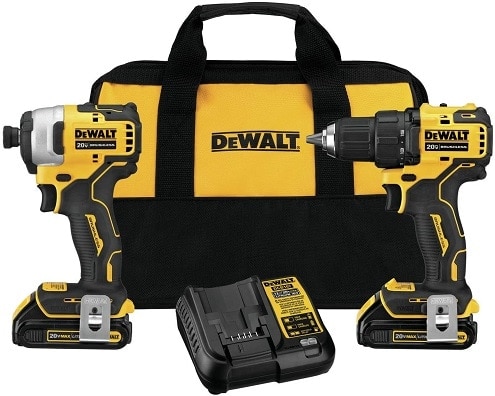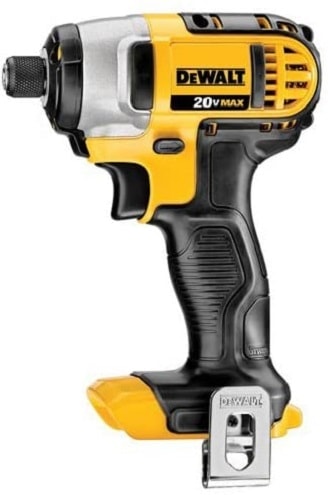DeWalt Atomic vs XR: Which Tool is Better in 2025?
-
Pete Ortiz
- Last updated:

The Atomic line of power tools is one of the most recent additions to the DeWalt arsenal. It uses the same 20V MAX battery packs that the well-known XR line of tools uses, but the Atomic line promises a sleeker experience with more compact tools. The Atomic line isn’t as diverse as the XR line. It’s newer, but there aren’t as many options available.
You can find more affordable tools in the XR line, but they’ll be less powerful and larger than the Atomic tools. You can also find more powerful tools in the XR line, but these will generally be more costly than the equivalent tool in the Atomic line, with the Atomic tool still coming in a bit smaller and slimmer.
At a Glance
Let’s look at the key points of each product.
- Uses 20V MAX battery packs
- Smaller and lighter
- Brushless motors
- Affordably priced for brushless motors
- Uses 20V MAX battery packs
- More powerful
- Brushless motors
- More tools in the XR lineup
Overview of DeWalt Atomic:
The Atomic line was first introduced in the spring of 2019, promising powerful tools with compact profiles. They lived up to the advertising, with Atomic models offering some of the most compact DeWalt models to date.
A More Streamlined Approach
The biggest draw of the Atomic line is its smaller size. Tools that are part of the Atomic family generally weigh less than any of their counterparts from the XR lineup. If you measure them, the Atomic version will usually be smaller than even the priciest XR you could compare it to. This was supposed to be one of the main features of the Atomic line, and it seems that DeWalt really delivered on this front.
Still Loaded with Power
Despite the smaller size, DeWalt promised that the Atomic line would still be packed with power. After all, a smaller tool won’t be as useful if it’s underpowered. While the Atomic tools aren’t the most powerful in the DeWalt lineup, they do tend to be more powerful than many of the comparable XR models. Much of this is thanks to the powerful brushless motors used in the Atomic line.
The XR range is much more diverse than the Atomic range. There are several versions of each tool in the XR lineup, spanning a range of prices and features. But the Atomic tools tend to be nearly as powerful as the top-end XR tools, outpowering the tools at the lower end of the XR range.
More Affordably Priced
Though they tend to outpower many of the tools in the XR family, and they’re smaller than pretty much any similar tools in the DeWalt cordless lineup, the Atomic tools are some of the most affordable tools in the DeWalt stable.
- Some of the most compact tools from DeWalt
- They still have plenty of power
- Affordably priced
- Brushless motors
- They’re not the most powerful tools from DeWalt
Overview of DeWalt XR:
The DeWalt XR line is the main staple of DeWalt’s cordless power tool family. First introduced in 2013, the XR line includes tools with brushless motors and lithium-ion batteries.
XR Spans a Range
The XR lineup contains a wide range of tools at various price points that offer several different levels of performance. Comparatively, the Atomic line of DeWalt tools is much smaller. DeWalt may add to this line in the future, but for now, there aren’t as many options within the Atomic family. This makes it a bit harder to compare XR tools against the Atomic line since there are so many different choices.
More Powerful and More Expensive
While some models from the XR line are cheaper than the equivalent tool from the Atomic lineup, the XR tools tend to be the more expensive choices overall. This is especially true if you’re looking at the higher-end XR tools that can actually compete with the Atomic lineup when it comes to performance. But if you keep looking higher up the XR model line, you’ll find some tools that offer notably improved performance over the Atomic line.
Bulkier and Heavier
Whether you’re looking at the most powerful or worst-performing picks from the XR lineup, they’re all bigger than the Atomic equivalent. One of the main features of the new Atomic lineup is that they’re compact, and most of the tools in the Atomic lineup are smaller than any of their XR equivalents.
- There are more options to choose from
- The most powerful tools are in the XR lineup
- They’re bigger than tools from the Atomic line
- They’re heavier than Atomic tools
- They tend to cost more than their Atomic equivalents
How Do They Compare?
Size
Edge: Atomic
The DCF885B, one of DeWalt’s most popular and affordable impact drivers, measures 5.55 inches in length, compared to the 5.1-inch length of the DCF809 Atomic impact driver. Even the DCF887, DeWalt’s flagship and more expensive impact driver, measures 0.2 inches longer than the Atomic model at 5.3 inches.
Performance
Edge: XR
Let’s keep comparing the same impact drivers. The Atomic DCF809 impact driver is rated at 1,700 inch-pounds of torque and can produce a peak of 3,200 impacts per minute. Compared to the DCF885, the Atomic is far more powerful. The DCF885 tops out at 1,400 inch-pounds maximum torque but manages the same 3,200 impacts per minute. At the higher end of the XR range, the DCF887 slightly outperforms the Atomic model with 1,825 inch-pounds maximum torque and a peak of 3,600 impacts per minute.
So, the Atomic isn’t the most powerful of the bunch, but it does put up respectable numbers. It’s slightly outperformed by the DCF887 but manages far more power than the DCF885. Still, the XR line does offer more powerful options if power is the most important factor for you.
Price
Edge: Atomic
Despite being far more powerful and compact than the DCF885 XR impact driver, the DCF809 is actually more affordable, though only by a small margin. The DCF887 is a much higher-end model from the XR family that outprices both of the other models we mentioned, and while it did offer more power than the Atomic impact driver, the Atomic was still smaller. Overall, the Atomic line offers some of the most affordable power tools that are available from DeWalt right now.
Weight
Edge: Atomic
In the XR line, the two impact drivers we’re comparing against the Atomic model are the DCF885 and the DCF887, both of which weigh in at 2.65 pounds with no battery installed. Once again, the DCF809 Atomic impact driver beats both of these models, weighing in at a mere 2.1 pounds without the battery.
What the Users Say
We’ve done our best to offer a fair comparison of these two tool lines. But there are many opinions out there, and these tools have been used by many people. So, we searched the internet, reading through forums, reviews, and comments to figure out what real-world users thought after using these tools.
Across the board, users were mostly pleased with tools from both lineups. People with experience with tools in both lineups seemed to love the smaller size of the new Atomic tools. Many people expressed their surprise at how light and compact the tools were once they used them.
Some reported satisfaction with the power of the Atomic line against the XR line. A common comment was that the batteries lasted far longer than expected with Atomic tools. And no one seemed displeased at the affordable price they paid. Many users even said the tools were worth more than what they spent.
Conclusion
There was a lot of hype surrounding the DeWalt Atomic line of tools. Luckily, they lived up to expectations and matched the hype with a line of compact, lightweight tools that still had plenty of power. If you need the most powerful cordless tools possible, you’ll still want to use the high-end XR offerings. For everyone else, the Atomic line represents a more affordable way to get plenty of power in a tool that’s smaller and more user-friendly than anything in the XR line.
Contents










